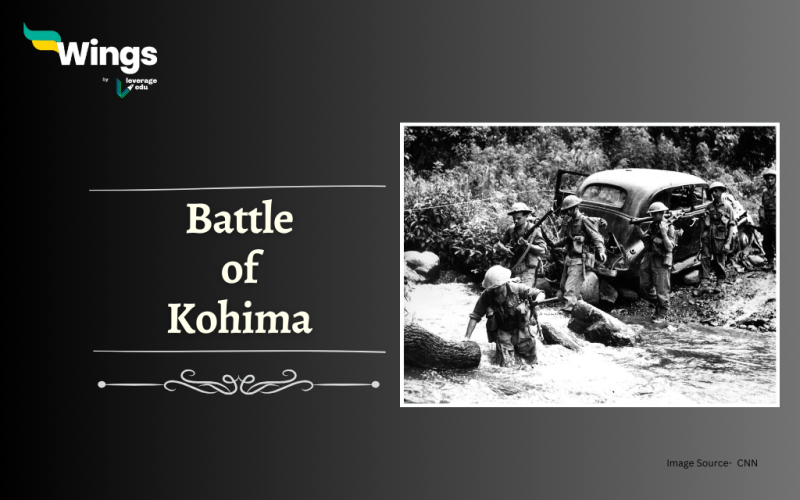The battle of Kohima began on April 4, 1944, and was one of the most ferocious battles of World War II. The battle was fought between the British army and Indian forces against the Japanese advancements in the north-eastern part of India, and the Japanese were defeated, marking the start of the Allied invasion of Burma. In this blog, we will get to know more about the battle of Kohima and its background, outcome and facts.
Table of Contents [show]
Background Of the Battle of Kohima
In 1944, at the height of World War II, the Japanese invaded India through Burma under the codename ‘Operation U Go’. The objective was to invade the northeast of the country through Burma.
- The Japanese wanted to capture Kohima, the capital of what is now Nagaland, and the surrounding area.
- The Japanese had a relatively small force of about 2500 men, while the British had 12,000 men.
- The Japanese hoped to take Kohima, then Assam, and then march to Delhi. However, the Indian and British forces fought bravely and foiled the Japanese’s ambitious plans.
- In March 1944, Japan invaded India through the dense jungles of the area from Burma to India.
- The Japanese first attacked Imphal, which surprised the British. Then they looked at Kohima and its garrison. The garrison was relatively unknown, as this part of India was not crucial to the British’s plans.
- So, with the odds clearly in their favour, the Japanese invaded Kohima with the aim of taking the town itself.
Also Read – Battle Of Porto Novo: Background, Outcome & More
Events of the Battle of Kohima
The British held on to their strategic positions and harassed the Japanese with heavy artillery firing.
- The Japanese were also concerned about the shortage of supplies. They brought 5000 oxen with them to be slaughtered for sustenance purposes, but most of them died along the way.
- On the other hand, there were many battles fought at the garrison, including at the bungalow and tennis court of the deputy commissioner. This was known as the Battle of the Tennis Court.
- Many men also engaged in hand-to-hand combat. The death toll reached in the thousands and many more were sickened by the smell of rotting corpses.
- The supply lines were exhausted on both sides, but the soldiers kept fighting.
- The British reinforcements arrived at Dimapur from Kohima to relieve the forces. The Japanese however, now realized that their position was tenuous, and they began to retreat.
- The Japanese were defeated in the subsequent battle of Imphal. The Indians and British lost about 4000 men in the battle, while the Japanese lost between 5000 and 7000 men.
- The battle is also known as the Battle of the Eastern Theater.
- The battle was voted Britain’s greatest battle by the National Army Museum.
- Today, where the Deputy Commissioner’s tennis court used to be, there’s a war cemetery. There’s even a poem written on a Kohima gravestone:
“Tell them of us, and say, ‘We gave our today for your tomorrow.’“
- The battle won the eastern theatre of the war and laid the foundations for the Japanese retreat.
Also Read – Battle Of Ten Kings: Background, Event, Outcome & More
Kohima War Cemetery
Kohima War Cemetery is located at the heart of Kohima in Nagaland. It is a memorial to the 2nd British division of the Allied Forces who died in World War II at the battle of Kohima, the capital of Nagaland, in April 1944.
According to the Commonwealth War Graves Commission, which maintains this and many other war cemeteries around the world, these soldiers died on the battlefield of Garrison Hill, which is located close to the tennis court area of the deputy commissioner’s residence.
Facts About Kohima War Cemetery
- This war cemetery is home to 1,420 graves of Commonwealth soldiers from World War II.
- It also houses a monument to 917 Hindus and Sikhs who had their ashes cremated in accordance with their religious beliefs.
- The memorial was presented by the 14th army in Burma’s then Commander, Sir William Slim.
- The battle of Imphal and Kohima was named “Britain’s greatest battle” by the British National Army Museum in 2013.
Relevant Blogs
This was all about the Battle of Kohima. For more content related to the different states of India, visit our articles like this, you can get Study notes on the Modern History of India here. Also, you can visit our general knowledge page on Indian History!
 One app for all your study abroad needs
One app for all your study abroad needs















 45,000+ students trusted us with their dreams. Take the first step today!
45,000+ students trusted us with their dreams. Take the first step today!
